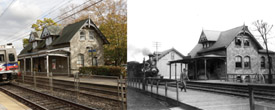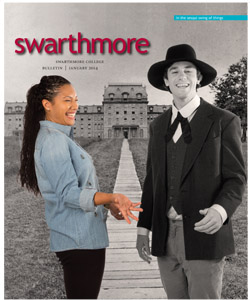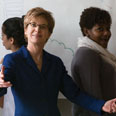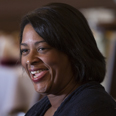By Carrie Compton
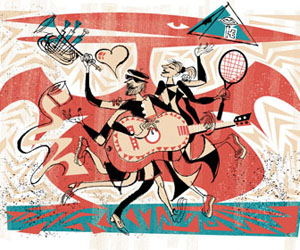
Book and Key Society
“I remember the induction of members of Book and Key, when a ghastly hand came out the door and pulled the new member in.”
—Andy Wilcox Palmer ’51
An eerie and windowless pyramid once stood at the end of Whittier Place on Elm Street. What happenedinside was unknown to all but seven senior men. This was Swarthmore’s secret Book and Key Society, which endured from 1906 to 1966. The club, founded by Morris L. Clothier, Class of 1890, and Howard Cooper Johnson, Class of 1896, was consciously modeled on secret societies at Yale.
The Temple, as the Egyptian-style clubhouse came to be known, was paid for by Clothier, and in 1906, the first seven “bookies” were initiated. Club members were known to get up from the dining hall at seven minutes to 7 each Thursday night to begin a silent, strange procession to the Temple for their weekly meeting.
By Sherri Kimmel
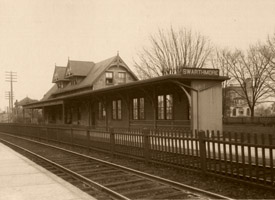
Few institutions of higher learning are bisected by a major highway. Dickinson College and James Madison University come to mind. But a railroad running through the campus proper? Perhaps only at Swarthmore. At least that’s what Jim Bock ’90, vice president and dean of admissions, speculates.
Related Articles
By Sherri Kimmel
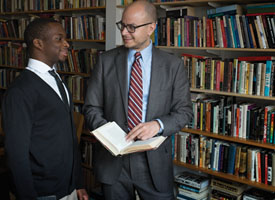
Phoenix reporter Eric Glover ’07 had no intention of investigating his own life when he entered the Parrish Hall office of Myrt Westphal, associate dean of student life, one day his sophomore year. But after Glover interviewed the now-retired dean for a story on residence life, she turned the questions in his direction.
“I remember telling her I was very interested in dramatic criticism and theater in general,” Glover recalls. “When I matriculated at Swarthmore I thought I would be either a writer or a critic. It never occurred to me that I could also aspire to become a college professor.”
By Carol Brévart-Demm
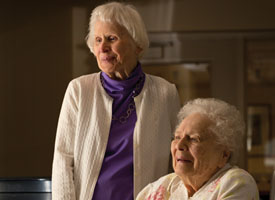
Anne Bowly Maxfield and Gertrude “Trudy” Bell, graduates of the Class of 1934, have been friends for 80 years. Although understandably less physically fit and nimble than in their college days, their memories are remarkable, their demeanor playful, and their humor infectious. They are both quite beautiful. And they are both 100 years old.
By Jamie Stiehm ’82
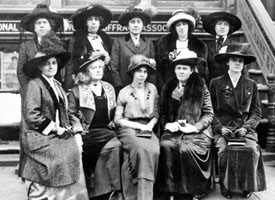
Friends, readers, countrypeople, meet one of the greatest alumnae in the American history pantheon. Our own beautiful revolutionary, Alice Paul, Class of 1905, was far ahead of her time—and President Woodrow Wilson—a century ago. Their clash over “Votes for Women,” her thoroughly modern seven-year campaign, was bitter and personal. By the time Paul burnt Wilson’s speeches in a “Watchfire Protest,” the president and the suffragist had met several times and could not stand each other. She gave him no peace even in wartime.
By Carol Brévart-Demm
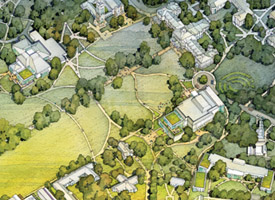
When Joseph Swain became Swarthmore’s sixth president in 1891, his vision included the following: “A college … must be so conducted that while best serving each generation in its turn, it will ever adapt itself to the new and larger wants of the rising one.”
Related Article
By Rebecca Chopp
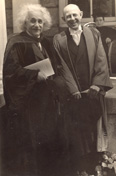
Pictures of two “practical visionaries” stand watch over my office here at the College. The first is of Lucretia Mott—Swarthmore founder, leading abolitionist, organizer of the landmark Seneca Falls Convention, gifted preacher, devoted wife and mother of six, and tireless organizer for causes in which she believed. Lucretia Mott is revered as the progenitor of women’s political advocacy and social action in this country.
By Sherri Kimmel
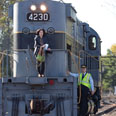
I’m no George Plimpton, but I do enjoy participatory journalism, especially when it involves climbing around on a train. Well, participatory may be stretching it. I wasn’t pulling the throttle on the train engine. I was just along for the ride with Conductor Frank Moscatelli, whose day job is teaching physics at Swarthmore.
Sitting in a primo spot beside the engineer, I looked out beyond the wooden ties and steel rails to see the fall colors unfold before me.

In the midst of one of the many midday meals chronicled in My Lunches With Orson, edited by Peter Biskind ’62, Orson Welles starts venting to his perennial companion, the director Henry Jaglom, about the unpleasant experience of reading a biography of the poet Robert Graves. It’s not that the book was bad, Welles explains, but “I learned more about him than I wanted to know.”
That’s certainly a danger with Lunches, which finds Welles near the end of his career and, unknowingly, his life.
By Laurie Gerber ’96

Sophomore year, 1993, Will Craig ’96 and I met in an education class. We married five years later in the amphitheater. Less than 10 years into our marriage, we lived in Manhattan with two toddlers. I was running a tutoring company, and Will was running a home day care while trying to renovate a townhouse we’d just gone out on a very thin limb to purchase, after the contractor had mysteriously disappeared. We were also having trouble selling the home we lived in to create the cash for the new one.
 Book and Key Society
“I remember the induction of members of Book and Key, when a ghastly hand came out the door and pulled the new member in.”
—Andy Wilcox Palmer ’51
An eerie and windowless pyramid once stood at the end of Whittier Place on Elm Street. What happenedinside was unknown to all but seven senior men. This was Swarthmore’s secret Book and Key Society, which endured from 1906 to 1966. The club, founded by Morris L. Clothier, Class of 1890, and Howard Cooper Johnson, Class of 1896, was consciously modeled on secret societies at Yale.
The Temple, as the Egyptian-style clubhouse came to be known, was paid for by Clothier, and in 1906, the first seven “bookies” were initiated. Club members were known to get up from the dining hall at seven minutes to 7 each Thursday night to begin a silent, strange procession to the Temple for their weekly meeting.
Book and Key Society
“I remember the induction of members of Book and Key, when a ghastly hand came out the door and pulled the new member in.”
—Andy Wilcox Palmer ’51
An eerie and windowless pyramid once stood at the end of Whittier Place on Elm Street. What happenedinside was unknown to all but seven senior men. This was Swarthmore’s secret Book and Key Society, which endured from 1906 to 1966. The club, founded by Morris L. Clothier, Class of 1890, and Howard Cooper Johnson, Class of 1896, was consciously modeled on secret societies at Yale.
The Temple, as the Egyptian-style clubhouse came to be known, was paid for by Clothier, and in 1906, the first seven “bookies” were initiated. Club members were known to get up from the dining hall at seven minutes to 7 each Thursday night to begin a silent, strange procession to the Temple for their weekly meeting.  Few institutions of higher learning are bisected by a major highway. Dickinson College and James Madison University come to mind. But a railroad running through the campus proper? Perhaps only at Swarthmore. At least that’s what Jim Bock ’90, vice president and dean of admissions, speculates.
Few institutions of higher learning are bisected by a major highway. Dickinson College and James Madison University come to mind. But a railroad running through the campus proper? Perhaps only at Swarthmore. At least that’s what Jim Bock ’90, vice president and dean of admissions, speculates.
 Phoenix reporter Eric Glover ’07 had no intention of investigating his own life when he entered the Parrish Hall office of Myrt Westphal, associate dean of student life, one day his sophomore year. But after Glover interviewed the now-retired dean for a story on residence life, she turned the questions in his direction.
“I remember telling her I was very interested in dramatic criticism and theater in general,” Glover recalls. “When I matriculated at Swarthmore I thought I would be either a writer or a critic. It never occurred to me that I could also aspire to become a college professor.”
Phoenix reporter Eric Glover ’07 had no intention of investigating his own life when he entered the Parrish Hall office of Myrt Westphal, associate dean of student life, one day his sophomore year. But after Glover interviewed the now-retired dean for a story on residence life, she turned the questions in his direction.
“I remember telling her I was very interested in dramatic criticism and theater in general,” Glover recalls. “When I matriculated at Swarthmore I thought I would be either a writer or a critic. It never occurred to me that I could also aspire to become a college professor.”  Anne Bowly Maxfield and Gertrude “Trudy” Bell, graduates of the Class of 1934, have been friends for 80 years. Although understandably less physically fit and nimble than in their college days, their memories are remarkable, their demeanor playful, and their humor infectious. They are both quite beautiful. And they are both 100 years old.
Anne Bowly Maxfield and Gertrude “Trudy” Bell, graduates of the Class of 1934, have been friends for 80 years. Although understandably less physically fit and nimble than in their college days, their memories are remarkable, their demeanor playful, and their humor infectious. They are both quite beautiful. And they are both 100 years old.
 Friends, readers, countrypeople, meet one of the greatest alumnae in the American history pantheon. Our own beautiful revolutionary, Alice Paul, Class of 1905, was far ahead of her time—and President Woodrow Wilson—a century ago. Their clash over “Votes for Women,” her thoroughly modern seven-year campaign, was bitter and personal. By the time Paul burnt Wilson’s speeches in a “Watchfire Protest,” the president and the suffragist had met several times and could not stand each other. She gave him no peace even in wartime.
Friends, readers, countrypeople, meet one of the greatest alumnae in the American history pantheon. Our own beautiful revolutionary, Alice Paul, Class of 1905, was far ahead of her time—and President Woodrow Wilson—a century ago. Their clash over “Votes for Women,” her thoroughly modern seven-year campaign, was bitter and personal. By the time Paul burnt Wilson’s speeches in a “Watchfire Protest,” the president and the suffragist had met several times and could not stand each other. She gave him no peace even in wartime.  When Joseph Swain became Swarthmore’s sixth president in 1891, his vision included the following: “A college … must be so conducted that while best serving each generation in its turn, it will ever adapt itself to the new and larger wants of the rising one.”
When Joseph Swain became Swarthmore’s sixth president in 1891, his vision included the following: “A college … must be so conducted that while best serving each generation in its turn, it will ever adapt itself to the new and larger wants of the rising one.” 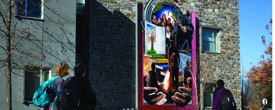
 Pictures of two “practical visionaries” stand watch over my office here at the College. The first is of Lucretia Mott—Swarthmore founder, leading abolitionist, organizer of the landmark Seneca Falls Convention, gifted preacher, devoted wife and mother of six, and tireless organizer for causes in which she believed. Lucretia Mott is revered as the progenitor of women’s political advocacy and social action in this country.
Pictures of two “practical visionaries” stand watch over my office here at the College. The first is of Lucretia Mott—Swarthmore founder, leading abolitionist, organizer of the landmark Seneca Falls Convention, gifted preacher, devoted wife and mother of six, and tireless organizer for causes in which she believed. Lucretia Mott is revered as the progenitor of women’s political advocacy and social action in this country.
 I’m no George Plimpton, but I do enjoy participatory journalism, especially when it involves climbing around on a train. Well, participatory may be stretching it. I wasn’t pulling the throttle on the train engine. I was just along for the ride with Conductor Frank Moscatelli, whose day job is teaching physics at Swarthmore.
Sitting in a primo spot beside the engineer, I looked out beyond the wooden ties and steel rails to see the fall colors unfold before me.
I’m no George Plimpton, but I do enjoy participatory journalism, especially when it involves climbing around on a train. Well, participatory may be stretching it. I wasn’t pulling the throttle on the train engine. I was just along for the ride with Conductor Frank Moscatelli, whose day job is teaching physics at Swarthmore.
Sitting in a primo spot beside the engineer, I looked out beyond the wooden ties and steel rails to see the fall colors unfold before me.

 In the midst of one of the many midday meals chronicled in My Lunches With Orson, edited by Peter Biskind ’62, Orson Welles starts venting to his perennial companion, the director Henry Jaglom, about the unpleasant experience of reading a biography of the poet Robert Graves. It’s not that the book was bad, Welles explains, but “I learned more about him than I wanted to know.”
That’s certainly a danger with Lunches, which finds Welles near the end of his career and, unknowingly, his life.
In the midst of one of the many midday meals chronicled in My Lunches With Orson, edited by Peter Biskind ’62, Orson Welles starts venting to his perennial companion, the director Henry Jaglom, about the unpleasant experience of reading a biography of the poet Robert Graves. It’s not that the book was bad, Welles explains, but “I learned more about him than I wanted to know.”
That’s certainly a danger with Lunches, which finds Welles near the end of his career and, unknowingly, his life.
 Sophomore year, 1993, Will Craig ’96 and I met in an education class. We married five years later in the amphitheater. Less than 10 years into our marriage, we lived in Manhattan with two toddlers. I was running a tutoring company, and Will was running a home day care while trying to renovate a townhouse we’d just gone out on a very thin limb to purchase, after the contractor had mysteriously disappeared. We were also having trouble selling the home we lived in to create the cash for the new one.
Sophomore year, 1993, Will Craig ’96 and I met in an education class. We married five years later in the amphitheater. Less than 10 years into our marriage, we lived in Manhattan with two toddlers. I was running a tutoring company, and Will was running a home day care while trying to renovate a townhouse we’d just gone out on a very thin limb to purchase, after the contractor had mysteriously disappeared. We were also having trouble selling the home we lived in to create the cash for the new one.
